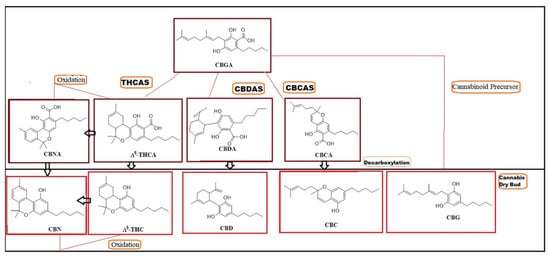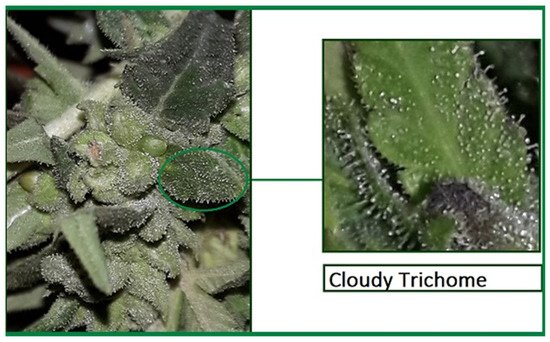Cannabis has been a traditional medicinal herb in central Asia, with reports of such usage back to 4700 B.P. in China, India, Persia, Egypt, Greece and Rome. It is now also cultivated and used as a drug crop in at least 172 countries and territories worldwide. It is classified as Cannabis Sativa, C. Indica and C. Ruderalis based on genetics, phenotypic properties and chemical structure. The Cannabis industry is rapidly growing; therefore, there is no medicinal cannabis that can be produced without optimising drying methods. Producing high-quality medical products have been a hot topic in recent years.
1. Introduction
Cannabis has been a traditional medicinal herb in central Asia [
1], with reports of such usage back to 4700 B.P. in China, India, Persia, Egypt, Greece and Rome [
1]. It is now also cultivated and used as a drug crop in at least 172 countries and territories worldwide [
2]. It is classified as
Cannabis Sativa,
C. Indica and
C. Ruderalis based on genetics, phenotypic properties and chemical structure [
3]. All the classes have medicinal cannabinoids compounds, but in different proportions. For instance,
Cannabis Sativa has a high level of Cannabidiol (CBD), while
C. Indica and
Rudelaris have high and low levels of Δ
9-tetrahydrocannabinol (THC) respectively [
3,
4,
5].
Aizpurua-Olaizola, et al. [
6] listed 554 compounds identified in
Cannabis plants, including 125 cannabinoids and 198 non-cannabinoid compounds like phenols and flavonoids, terpenes and alkaloids [
7,
8]. Cannabinoids are the active medicinal constituents against the development of numerous conditions. CBD has therapeutic activity against antipsychotic, anti depressive, anxiolytic, antiepileptic, anti spasticity and anti-inflammatory, stroke and hypoxic-ischemic, spinal cord injury, rheumatoid arthritis and various types of cancer, such as brain, blood, breast, lung, prostate and colon [
9,
10,
11,
12,
13,
14]. However, THC is well-documented having anti-inflammatory effects, including for arthritic and inflammatory conditions [
15], Alzheimer’s disease [
16], Parkinson’s [
17] and diabetes [
18]. However, cannabigerol (CBG) and cannabichromene (CBC) have antibacterial and antifungal effects [
19], and can act as antidepressants [
20]. In contrast, cannabinol (CBN) has a potential effect on insomnia and sleep disorder [
21].
Production of cannabinoids in
Cannabis is mainly derived from cannabigerolic acid (CBGA), or the mother of the
Cannabis via co-enzyme Olivetolate geranyl transferase such as tetrahydrocannabinolic acid synthase (THCAS) cannabidiolic acid synthase (CBDAS) or cannabichromene acid synthase (CBCAS) [
22], to produce tetrahydrocannabinolic acid (THCA), cannabidiolic acid (CBDA) and cannabichromenic acid (CBCA), and oxidation of THCA to produce cannabinolic acid (CBNA) in the resin glands or trichomes [
23,
24]. Then these naturally cannebinoids acids are converted via decarboxylation, which removes the carboxylic acid functional group from the cannabinoids via drying, heating or combustion to produce CBD, CBC, CBG and oxidation THC to Delta-8-tetrahydrocannabinol (Δ
8-THC) and CBN [
25,
26,
27] (
Figure 1).
Figure 1. Structures of major components in the medicinal Cannabis. cannabigerolic acid, CBGA; tetrahydrocannabinolic acid synthase, THCAS; cannabidiolic acid synthase, CBDAS; cannabichromene acid synthase, CBCAS; tetrahydrocannabinolic acid, THCA; cannabidiolic acid, CBDA; cannabichromenic acid, CBCA; cannabinolic acid, CBNA; cannabichromene, CBC; cannabidiol, CBD; cannabigerol, CBG; cannabinol, CBN; and tetrahydrocannabinol, THC.
Medicinal
Cannabis has traditionally been used to treat various illnesses using different plant parts [
28]. According to Jin, et al. [
29], leaves are rich in cannabinoids (1.10–2.10%), terpenoids (0.13–0.28%) and flavonoids (0.34–0.44%). The seed oil is mostly used in Arab and Chinese medicine [
30,
31]. However, a product derived from seed and its concentration still required further study [
32]. In addition, a recent study by Lima, et al. [
33] reported no spasmolytic effect, no toxicity effect and reduction in edema formation at all tested doses (12.5, 25, 50 and 100 mg/kg) of aqueous extract of
Cannabis Sativa roots (CsAqEx) on the airway smooth muscle in mice. In modern medicine, however,
Cannabis female inflorescence is the most used part of the plant, and contains the highest concentration of different cannabinoids and active terpenes [
34].
C. Sativa species regulated the cell death in the plant via accumulated cannabinoids in the glands above the leaf [
35]. Over 300 years, the functions of these glands have been well known as either attracting pollinators or protecting against pathology. However,
Cannabis glands contributed additional functions as death capsules [
36,
37]. These cannabinoids result from secondary metabolism in
Cannabis [
38]. Cannabinoids accumulate where death happens in the plant tissue [
39]. Cannabinoid resin causes necrotic and apoptotic cells through DNA degradation mediated by caspase-dependent nuclease and catalysed by nuclease released from mitochondrial during action mitochondrial permeability transition (MPT) [
39]. Secretion of these cannabinoids or treating the plant with these cannabinoids will stimulate the defense system during the initial and late stages of the leaf senescence [
36,
37]. Another significant benefit is to fulfil the requirement for the completed growth cycle and eventually develop the seeds in the medicinal
Cannabis [
36]. In general, senescence happens during all growing cycles, and then ultimately leads to death [
40]. This death plays an essential role in diverse physiological actions, including root cap, stomatic embryogenesis, xylogenesis, leaf senescence and defense against microbial pathogens and abiotic stresses [
41]. Due to secondary metabolites, changes in the active compounds like THCA and THC led to altered chemical composition [
38,
42].
2. Harvesting of Cannabis
There is a significant difference in the potency, quality and content of cannabinoids and terpenes between unripe and ripe buds [
26,
49,
50]. When the bud is ripe, it is the best time to harvest
Cannabis [
50]. Therefore, daily bud inspections and extra time to harvest will feature multiple harvesting sessions to ensure the finest harvest and best quality to process medicinal
Cannabis [
49]. The following section will explain how to determine the time to harvest and the best harvesting technology.
2.1. Determining the Time to Harvest
Daily observation of the flower is required to determine when caps swell with resin and trichomes become more prominent, liquid accumulates and stand erect and sticky [
49,
51,
52]. Maximum cannabinoid composition occurs when the trichomes’ colour changes into white, cloudy or milky, instead of the clear colour as shown in
Figure 2. The buds then produce high THC [
49,
51,
53,
54].
Figure 2. Morphological appearance of white or milky trichome of medicinal Cannabis.
When the pastel hair colour turns to 75% light brown or amber, then inflorescences are ready for the harvest with a total CBD peak of 8.73% [
55,
56,
57]. However, once the trichome starts looking grey and much of the THC has already degraded to CBN, the harvest time has passed, and the effects of the buds will be sleepy without any psychoactive effects [
53,
54,
55]. Another method that has been used to determine the best time for the harvest of medicinal
Cannabis is examining the physical appearance and budding mass by a digital microscope, 60× magnification via UV and LED light, magnifying glass and photographerloupe [
49,
54,
58]. When the
Cannabis is small, all the buds ripen simultaneously, but when the plant is larger, the first 3–6 inches of buds ripen before the inner buds [
56]. In general, commercial harvest occurs after plants grow for 8–9 weeks, depending on the strain [
52,
56,
59,
60].
2.2. Harvesting Technology
The harvesting process happens when the medicinal
Cannabis is in full flourishing [
61,
62,
63]. In general, the manual process is the only way that has been used to harvest medicinal
Cannabis without damage and produce high-grade flowers [
64,
65,
66].
However, mechanical harvesting like rotary mowers and combined harvesting are used mainly for high-stalk bast-fibre like hemp [
64,
67,
68,
69,
70]. In general, a manual process is repeatable, low risk and maintains the crop’s quality [
71].
Trimming the flower shortly after harvest is especially extensive for a high-grade whole flower of medicinal
Cannabis [
71]. All tools used during harvesting should be purified or sterilised [
72]. There are four steps for trimming or manicuring ripe
Cannabis, including clipping then cut-off the buds from the stem. After that, snip away the more minor, multi-fin leaves surrounding the buds [
54,
73]. The bud, after this step, should look naked and only a couple of the leaves stick between the flowers, and these leaves must be clipped off from the petiole parts [
49]. The final steps before the drying are the wet trimming process, which includes removing the fan leaves, sugar leaves and any other extraneous parts of the plant, and collecting only manicured buds [
49,
74]. Different drying techniques have been applied for the drying of phytochemicals, and are summarised in
Table 1 and further discussed in
Section 3.
Table 1. Drying techniques for medicinal Cannabis buds.
|
Drying Technique
|
Drying Conditions/Procedures
|
Advantages and Disadvantage
|
References
|
|
Hot Air Drying
|
The plant materials were hanged on either string lines, wire cages, or static wires upside-down to allow for air circulation and uniform drying by control system has been set between 18–21 °C, relative humidity at 50–55% and air circulation using a small fan under these controlled conditions. Trimmed flowers take only 4–5 days, but the whole plant takes up to 14 days.
|
A simple technique, but required regularly maintain optimal conditions.
|
[59,75,76,77,78]
|
|
Oven Drying
|
Buds were hanging upside down in the oven and oven must be preheated at 37 °C for 24 h to prevent decarboxylation for Phyto cannabinoids
|
A simple technique, but under optimal conditions and difficult for commercial production.
|
[75,78,79]
|
|
Microwave-assisted hot air-drying
|
Samples were dried by applied volumetric heating and creating a temperature gradient and standard microwaves frequency set at 915 MHz and 240 W to maintain high-quality medicinal cannabis
|
An advanced technique, but under optimal conditions.
|
[80,81,82]
|
|
Vacuum Freeze-Drying
|
Vacuum freezing the cannabis bud by reducing the temperature to approximately −40 °C before drying the buds to retain a high quality of phytochemicals.
|
Quite effective and most suitable advanced technique, but prohibitive operational cost.
|
[83,84,85,86,87]
|
|
Microwave-Assisted Freeze Drying
|
Circulates cold, dry air over the frozen material at a temperature below −40 °C to −45 °C, pressure at 100 Pa, microwave frequency 2450 MHz.
|
An advanced technique, but under optimal conditions.
|
[76,88,89,90]
|
3. Drying of Cannabis
Many factors control the post-harvest quality. For instance, microbial activity, moisture content, room temperature, duration and light affect the quality and sustainability of medicinal
Cannabis [
45,
46], so few techniques have been developed to preserve the original phytocannabinoid and terpenoid contents [
43]. The most effective technique is drying, as
Cannabis contains approximately 80% water. Benefits from drying include controlling microbial activity and enabling long-term storage while maintaining potency, taste and medicinal properties [
75]. Most growers and commercial processors predicate the product is dry based on texture and crispness, while having only 11%
w/w of moisture [
76,
91]. Any change in drying conditions may cause decarboxylation of acidic cannabinoids, loss of terpenes and reduced product quality [
50]. Studies by ElSohly, Radwan, Gul, Chandra and Galal [
44] and Taschwer and Schmid [
45] found that the best way to avoid poor drying problems via a selection of drying techniques depending on the strain’s chemical profile, drying behaviour and the end product requirements. Several drying methods have been used to dry the flowers of
Cannabis, including hot air drying, oven drying, vacuum freeze-drying, atmospheric freeze-drying and microwave-assisted drying. Drying techniques for medicinal
Cannabis buds are summarised in
Table 1.
This entry is adapted from the peer-reviewed paper 10.3390/molecules27051719


